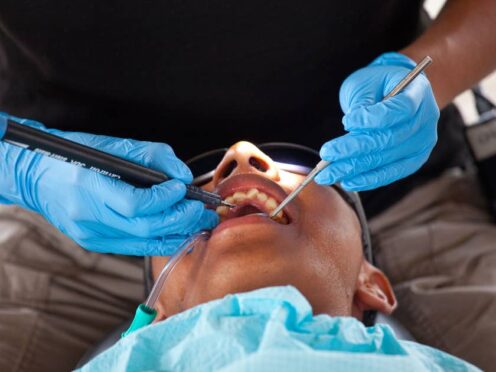Almost five million people have called the NHS’s 111 helpline with dental problems over the last five years, ministers have revealed.
Across the UK, people are struggling to access NHS dental care, either having to turn to private dentists or, in rare cases, carry out their own treatment.
Data acquired from the Government by the Labour Party has revealed about 965,050 people were referred for treatment as a result of calling the NHS non-emergency line in the last year alone.
The figures appear to show that demand for dental care via 111 increased during the pandemic, and has still not returned to normal levels in the years since.
Nearly 740,000 people were triaged in the year 2019-20, rising to 1,096,041 in the following year at the height of the pandemic.
A total of 4,780,044 people have been referred for dental treatment after calling the line to complain of dental problems since 2019.
The NHS recommends those in need of urgent or emergency dental treatment, who are not registered with a dentist, or who have been unable to do so, should call 111 for help.
Wes Streeting, the shadow health secretary, said: “The sky-rocketing number of 111 calls shows the Tories’ destruction on NHS dentistry is putting the rest of the NHS under greater pressure.

“After 14 years of Tory neglect, patients are desperately queuing around the block to see a dentist, literally pulling their own teeth out, and tooth decay is the number one reason young children are admitted to hospital. It’s time for a change.
“Labour has a plan to rescue NHS dentistry, and reform it for the long run. We will fund 700,000 extra urgent appointments a year; deliver a targeted recruitment scheme for dentists in left-behind areas; and we will get straight to work on reforming the outdated NHS dental contract.”
Health minister Dame Andrea Leadsom insisted that the Government’s plans to reform dental care would help more people access NHS dental care.
She was answering a separate question from Labour, which asked for an estimate of how many urgent and emergency dental appointments will be delivered as a result of the Government’s dentistry recovery plan.
Dame Andrea said: “Our dentistry recovery plan, backed by £200 million of funding, will make dental services faster, simpler, and fairer for National Health Service dental patients.
“It will fund approximately 2.5 million additional appointments, or more than 1.5 million additional courses of dental treatment.”
However, the minister admitted “no estimates are currently available of the number of urgent and emergency dental appointments that will be delivered through the plan”.
